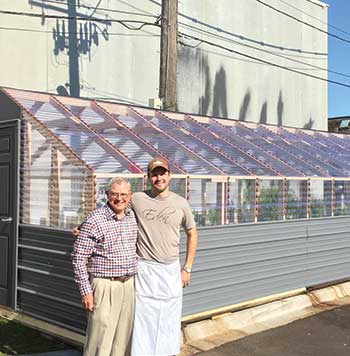Everyone's doing it. All types of restaurants source from local and smaller, regional farms these days, from fast-casual chains to multi-unit operations and higher end, independent restaurants. But dealing with delicate produce and larger cuts of meat entails some minor adjustments in terms of kitchen design, equipment, space and operations.
 Tre Rivali takes in half or whole pigs and breaks them down into pork chops, cured pork belly, braised pork shoulder and more. Here is a pork neck pappardelle."The biggest thing is storage," says Justin Casey, executive chef of Thomas Hill Organic Kitchen in San Luis Obispo, Calif. "We don't keep a lot of product in our walk-ins because we source directly from farms and go to the market four times a week. We spend more of our time shopping and prepping for use that day versus stocking up a walk-in cooler."
Tre Rivali takes in half or whole pigs and breaks them down into pork chops, cured pork belly, braised pork shoulder and more. Here is a pork neck pappardelle."The biggest thing is storage," says Justin Casey, executive chef of Thomas Hill Organic Kitchen in San Luis Obispo, Calif. "We don't keep a lot of product in our walk-ins because we source directly from farms and go to the market four times a week. We spend more of our time shopping and prepping for use that day versus stocking up a walk-in cooler."
Heather Terhune, executive chef of Tre Rivali at the new Kimpton Journeyman Hotel in Milwaukee, also finds she needs less storage, but more frequent deliveries for local produce. Heading up a 158-room hotel with 3 food and beverage outlets means she has access to a 6-day delivery schedule, often from local farms in the area via regional distributors. "Smaller deliveries are great because they don't take up more space and we want the freshest produce possible," she says.
Shopping at local markets or sourcing direct from small farms also cuts down on wasted material in the kitchen.
Casey returns boxes used to deliver food back to farmers and uses his own containers for any storage needs. When shopping at the markets, he'll take a wagon and reusable bags, but that's it. Likewise, Terhune also returns boxes to her farmers, and milk crates go back to the dairy farmers. She will, however, save cartons for eggs.
Joe Bozarth, lead chef at Fireside Pies, a multi-unit wood-fired, artisan pizza restaurant with five locations in Dallas and the surrounding suburbs, sources regional ingredients like Texas peaches, blueberries, beats, squash and zucchini. Add to that list Hatch chiles from New Mexico when in season to use for different pie toppings and salads. Like Terhune, he also gets produce delivered six times a week, running through most of it within a couple days.
 Fireside Pies features wood-fired artisan pizzas and focuses on regional ingredients for its side dishes."We don't want to hold the product for very long," Bozarth says. The only longer-term produce storage comes in the form of those chiles, peppers, mushrooms and onions, which are roasted off in the wood-fired oven for use later in sauces. When covered with balsamic vinegar overnight, the vegetables moisten a bit and the flavor develops even further, he says.
Fireside Pies features wood-fired artisan pizzas and focuses on regional ingredients for its side dishes."We don't want to hold the product for very long," Bozarth says. The only longer-term produce storage comes in the form of those chiles, peppers, mushrooms and onions, which are roasted off in the wood-fired oven for use later in sauces. When covered with balsamic vinegar overnight, the vegetables moisten a bit and the flavor develops even further, he says.
When it comes to washing, it's no different than sourcing conventional or organic produce — extra washing helps. "We always want to wash everything ourselves rather than rely on what someone else says they did," Casey says.
Traditional three-compartment sinks and salad spinners are essentials but for the very concerned, more advanced options include natural ozone technology.
"You can't be afraid of a little dirt or the occasional insect when you're working with farmers who aren't using pesticides," says Terhune, who's a fan of double washing. However, most farmers have already washed the produce themselves.
With so much fresh prep, the bigger concern for farm-to-table operations is finding enough space for all the necessary tables and chopping boards, or scheduling the prep work during off-peak times. Delicate lettuces can be especially tricky, Casey says, because they need to be washed for same-day use, and then cut just before service or risk wilting.
In-House Butchery
More chefs now choose to work with smaller, sustainable farms that typically deal in larger, primal cuts or whole or half animals. As such, in-house butchering has escalated in restaurants nationwide, which requires a few tweaks to kitchen setup and operations.
Thomas Hill Organic Kitchen cordons off a separate space for in-house butchery because of the frequency of the work. "We start with whole chickens and every piece of the animal is used, so we'll have pots running for stock using the bones and scraps," Casey says. "It might cost us a little more money as far as labor, but in the long run it costs us less overall and we have zero waste."
Not everyone can have a separate prep space and walk-in for in-house butchery, so Terhune simply stays organized and schedules the butchery on specific days at specific times depending on the delivery schedule. She'll take in half or whole pigs so she can make her own pork chops, cured pork belly, braised pork shoulder and more. For that she uses a hacksaw, cleaver, sharp butcher's knife and boning knife.
The more important need for an in-house butchery is enough freezer space if you're butchering large amounts of meat you can't use fast enough. For smaller cuts, Terhune vacuum seals as much as possible, even meat that will be used later that day or the next day to maintain freshness while cooling.
John Fink, chef and owner of The Whole Beast, a catering company and operator of a stall at San Francisco's The Hall, sources heritage-breed meats for his barbecue-based lineup.
"The size of the animal you get in is always an issue," Fink says. "You have to have the equipment and staff to deal with it quickly when it comes in — it's not a one- person project."
Fink opts to bring in half animals that he can break into primal cuts and then immediately brine the meat and put it into the smoker. Other parts are used for sausage and porchetta.
"It's really more about having a plan and using the meat right away than anything else," Fink says. He makes extra space in the cooler to hang pigs that have been processed only shortly prior to receiving them to help break down the lactic acid and tenderize the meat. He installed a small rail with a couple hooks to hang hogs between 105 to 275 pounds. It's possible to use sturdy shelves as long as they are not overloaded. For the prep space, he had a plastic cutting board specially made so it fits the 6-foot by 3.5-foot prep table with nonskid mats on the bottom.
When preparing sausage, Fink makes sure to keep all parts of the equipment, including the stuffer, grinder and mixer in the cooler to prevent the meat from warming too much during mixing.
"Less is more," Fink says. "You can have all these different knives, but they just take up space and all you really need is a sharp boning knife and to stay organized."
Hyper-Local Food
 Devon Quinn teamed up with his father (pictured at far left) to construct his own 1,800-square- foot greenhouse.Some chefs have taken farm-to-table one step further, setting up mini herb gardens in their kitchens, building their own rooftop gardens and even erecting greenhouses. Devon Quinn, chef/partner of the newly opened Eden in Chicago had the luxury of space due to his proximity to large-scale catering operation Paramount Events, to build his own greenhouse.
Devon Quinn teamed up with his father (pictured at far left) to construct his own 1,800-square- foot greenhouse.Some chefs have taken farm-to-table one step further, setting up mini herb gardens in their kitchens, building their own rooftop gardens and even erecting greenhouses. Devon Quinn, chef/partner of the newly opened Eden in Chicago had the luxury of space due to his proximity to large-scale catering operation Paramount Events, to build his own greenhouse.
A biologist in background, Quinn teamed up with his dad to build the 1,800-square-foot greenhouse. It's now home to more than 30 varieties of vegetables and herbs, such as scarlet turnips, pusa jamuni radish, Chinese green luobo radish, nasturtium, lemon balm, anise hyssop, cinnamon basil, wood sorrel, purple basil, mustard greens and more.
The produce grows in 18, 4-foot by 4-foot boxes, each about 2½ feet tall and built on plastic, industrial palettes so staff can easily move them around. Quinn uses organic leaf litter and mushroom compost to fertilize the garden. Exhaust and circulation fans, along with some greenhouse heaters, help maintain consistent temperatures and humidity levels. Quinn, with the help of staff, plants all the seeds in the greenhouse and harvests daily to have fresh produce for the restaurant. In the winter, he packs his harvest in insulated containers so the produce doesn't freeze while being transferred from the greenhouse to the restaurant across the outdoor parking lot.
The beauty of hyper-local food like this is the access to extremely fresh vegetables. "Most of the produce is never even refrigerated or only for a short period of time and we just run it through a cold water bath rinse to remove aphids before using it that day," Quinn says. He can also design his menu around what's growing and ready for harvest in the greenhouse.
 Eden in Chicago has its own greenhouse, allowing the restaurant to go hyper local in sourcing some of its ingredients. While most chefs at existing restaurants might not have access to the kind of space and resources needed to build greenhouses, more new restaurateurs are factoring in these considerations when buying and building out new real estate. Once considered impossible or unlikely, ensuring ample space for a rooftop, backyard or even hydroponic-powered kitchen garden has become the new reality and future of foodservice.
Eden in Chicago has its own greenhouse, allowing the restaurant to go hyper local in sourcing some of its ingredients. While most chefs at existing restaurants might not have access to the kind of space and resources needed to build greenhouses, more new restaurateurs are factoring in these considerations when buying and building out new real estate. Once considered impossible or unlikely, ensuring ample space for a rooftop, backyard or even hydroponic-powered kitchen garden has become the new reality and future of foodservice.




